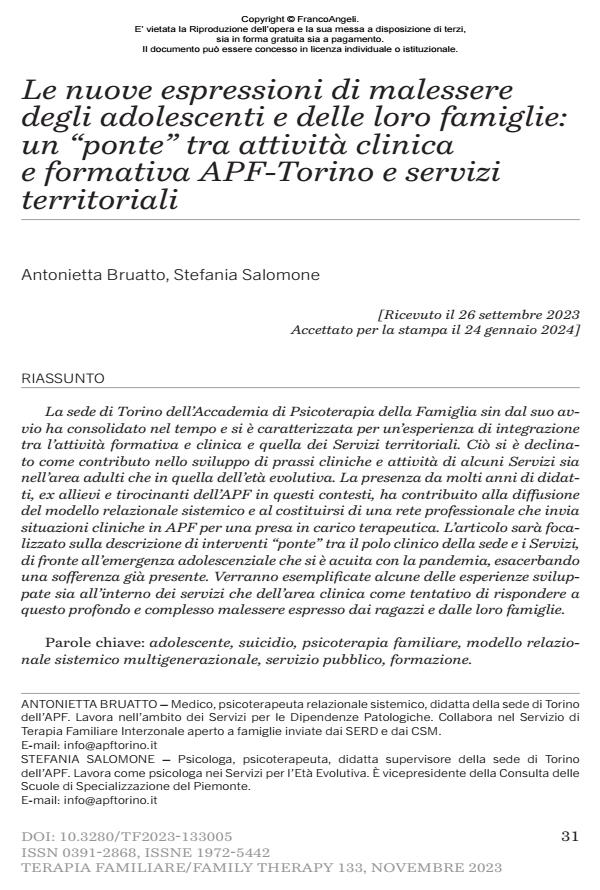Le nuove espressioni di malessere degli adolescenti e delle loro famiglie: un “ponte” tra attività clinica e formativa APF-Torino e servizi territoriali
Titolo Rivista TERAPIA FAMILIARE
Autori/Curatori Antonietta Bruatto, Stefania Salomone
Anno di pubblicazione 2024 Fascicolo 2023/133
Lingua Italiano Numero pagine 14 P. 31-44 Dimensione file 735 KB
DOI 10.3280/TF2023-133005
Il DOI è il codice a barre della proprietà intellettuale: per saperne di più
clicca qui
Qui sotto puoi vedere in anteprima la prima pagina di questo articolo.
Se questo articolo ti interessa, lo puoi acquistare (e scaricare in formato pdf) seguendo le facili indicazioni per acquistare il download credit. Acquista Download Credits per scaricare questo Articolo in formato PDF

FrancoAngeli è membro della Publishers International Linking Association, Inc (PILA)associazione indipendente e non profit per facilitare (attraverso i servizi tecnologici implementati da CrossRef.org) l’accesso degli studiosi ai contenuti digitali nelle pubblicazioni professionali e scientifiche
La sede di Torino dell’Accademia di Psicoterapia della Famiglia sin dal suo avvio ha consolidato nel tempo e si è caratterizzata per un’esperienza di integrazione tra l’attività formativa e clinica e quella dei Servizi territoriali. Ciò si è declinato come contributo nello sviluppo di prassi cliniche e attività di alcuni Servizi sia nell’area adulti che in quella dell’età evolutiva. La presenza da molti anni di didatti, ex allievi e tirocinanti dell’APF in questi contesti, ha contribuito alla diffusione del modello relazionale sistemico e al costituirsi di una rete professionale che invia situazioni cliniche in APF per una presa in carico terapeutica. L’articolo sarà focalizzato sulla descrizione di interventi “ponte” tra il polo clinico della sede e i Servizi, di fronte all’emergenza adolescenziale che si è acuita con la pandemia, esacerbando una sofferenza già presente. Verranno esemplificate alcune delle esperienze sviluppate sia all’interno dei servizi che dell’area clinica come tentativo di rispondere a questo profondo e complesso malessere espresso dai ragazzi e dalle loro famiglie.
Parole chiave:adolescente, suicidio, psicoterapia familiare, modello relazionale sistemico multigenerazionale, servizio pubblico, formazione.
Antonietta Bruatto, Stefania Salomone, Le nuove espressioni di malessere degli adolescenti e delle loro famiglie: un “ponte” tra attività clinica e formativa APF-Torino e servizi territoriali in "TERAPIA FAMILIARE" 133/2023, pp 31-44, DOI: 10.3280/TF2023-133005